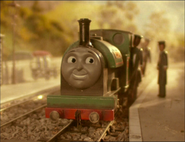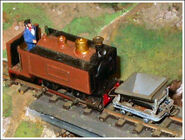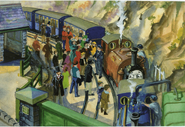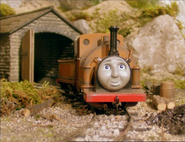
The Mid Sodor Railway's sheds
The Mid Sodor Railway was a 2'3" (Narrow Gauge) railway which operated from 1880 to 1947. Some parts of the line were later rebuilt for the 15" gauge Arlesdale Railway, but the majority of the line is still closed.
Planning
After its opening, the Sodor and Mainland Railway promised to build a branch line from Cronk; but nothing more was said and in 1870 the people of Peel Godred decided that they would have to build their own railway.
At first, the people were in favour of a line running down the valley to Cronk. This would certainly have been the simplest and cheapest, but it would have meant having to build a junction with the Sodor and Mainland, which was steadily becoming bankrupt. It was considered too risky a manoeuvre and they searched for another route.
Construction
The Peel Godred Committee approached several Cas-ny-Hawin mining companies, which had created a tramway to Arlesdale several decades ago. They saw the advantages of a connection with Peel Godred, and after several meetings at Ulfstead the Mid Sodor Railway Company was formed in 1872. The tramway was re-laid and the line was opened in 1874 with a station at Arlesburgh and three other stations: Arlesdale, Marthwaite and Ffarquhar Road.
The site selected for the station at Ulfstead Road stood 289 metres (867 feet) above sea level, 88 metres (264 feet) higher than but only 2.4 kilometres (1.6 miles) away from the next station at Cas-ny-Hawin. C. E. Spooner was consulted, but he was occupied with the North Wales Narrow Gauge Railway and the survey was undertaken by his son Edwin, who advised the railway climbed in a series of reverse loops, increasing the distance between the two to ten kilometres (six miles) and reducing the gradient. He also advised that the climb should be for eight kilometres (five miles) at a gradient of 1:100, which should be arranged in "steps" with level stretches between, his reasoning being it would allow engines to ease off or gain speed and motion before approaching the next climb. His results were accepted, but it called for four tunnels to be cut. This was where the trouble began. By the time two tunnels were cut the cost was exceeding expectations. They economised by cutting clearances to those that had been allowed for on the Ffestiniog, but even with this in mind they had little money left for the last few kilometres to Peel Godred. Although everything went smoothly with engineering here, plans for an elegant central station had to be scrapped in favour of a terminus on cheaper land in the outskirts alongside the Arlesburgh road.
The MSR later planned an extension from Peel Godred to Kirk Machan, but this would have required expensive engineering work and the plan was never carried out. The MSR, however, did take the liberty of moving the top station to Arlesdale.
Opening
The line was opened in October 1880. The line would have opened in June after an inspection by the Board of Trade, but the inspector was concerned by the few clearances in the mountain section and failed the line despite being unable to find any other faults. The Spooners pointed out that the clearances were safe when compared to the Ffestiniog's, and the inspector paid another visit at the end of September. The line passed on condition that safety precautions were followed, mainly that all doors were to be locked between Arlesdale and Ulfstead Road. This created no problems - water-stops were needed at both stations on the upward journey, while down trains required brake tests before descending, allowing time to lock carriage doors. Locals accepted the routine, but several visitors to Sodor complained at, in their words, "being imprisoned without trial". The company at least took notice of the complaints, but nothing changed; to them, tourists were decent enough, but they were not quite right in the head!
Traffic
The bulk of the passenger traffic was between Peel Godred and Arlesburgh, but it was the mines that were the real money-earners. Local traffic was slow to develop and the MSR was quick to encourage tourism. One feature which helped was an arrangement with the Isle of Man Packet Steamer Company allowing steamers to call at Arlesburgh twice daily in summer and twice weekly in winter.
The normal time to complete the forty-kilometre (twenty-five-mile) run was ninety minutes for most trains, but the pride of the line were the expresses run to meet with the steamers. These trains took priority, woe betide anything that hindered their punctuality. They stopped only at Arlesdale and Ulfstead Road and completed the run in seventy-five minutes. The passengers were usually carried in four bogie coaches, six on busy days.
Holidaymakers often took The Picnic, run between Easter and Michaelmas. It left Arlesburgh at ten and stopped at all stations and many beauty spots en route for ramblers and picnic parties. The return run left Peel Godred at half past three, arriving at Arlesburgh at ten past five in time for high tea at half-five.
Local goods traffic was slow to develop, and at first the guard's van carried parcels and small items. Mixed trains were attempted, but they were dropped after passengers complained at the delay shunting wagons. The company eventually provided a daily goods train, affectionately known as the "Horse and Cart" (coined by traders) for being so slow, which stopped anywhere and was allowed two and a half hours for the run. Passengers could hitch a ride in the brakevan for a payment equal to half the cost of the third-class fare, but the MSR wisely did not guarantee any arrival times.
Decline and Closure
In 1923, the Peel Godred Power Company was granted permission to build a dam and hydro-electric power plant 1.6 kilometres (one mile) north from the town. They considered using Arlesburgh and the MSR, but although the port was suitable the mountain clearances proved to be unsurpassable. An agreement was soon made with the recently formed North Western Railway to build a branch line from Killdane, which proved to be disastrous for the MSR as traffic from Peel Godred declined after its opening. The passenger trains from Peel Godred were almost empty most times of the year and by 1935 steamers ceased to call at Arlesburgh.
The mountain section was closed in 1936 when several engines and the bogie carriages were sold to keep the company running. After local traffic began to be transported by road the line returned to its humble beginnings as a tramway.
World War II brought much-needed traffic, but while the locomotives were maintained the track and rolling stock suffered. The mines were stripped and all eventually closed, with the last mine, at Cas-ny-Hawin, abandoned after flooding in December 1946. The railway was finally closed in January the following year, with Falcon running the last train. Falcon and another engine, Stuart, were sold to the Sodor Aluminium Company at Peel Godred for an expansion project and were sheeted for nearly a year after its completion in 1951 until both were sold again, this time to the Skarloey Railway for a total of fifty pounds. The third engine, Duke, was sheeted and left in the Arlesdale shed until his rediscovery in 1969. He was eventually restored, and returned to service on the Skarloey Railway in 1982.
In the 1960s, it was discovered that the lead spoils from the mines were very good weedkilling ballast. A 15" gauge railway, the Arlesdale Railway, was built in 1967 on much of the Mid-Sodor's old route to haul the lead spoils to Arlesburgh for the North Western Railway. The Arlesdale Railway also handles tourist and agricultural traffic.
Stations
There were two stations in Arlesburgh. Arlesburgh Bridge Street, the more convenient of the two, was the terminus; only trains connecting with the boat and mining block trains used the harbour station, Arlesburgh West. Arlesburgh Bridge Street had two platforms with a timber roof and an extensive yard for goods, locomotives and carriages.
Ffarquhar Road station had one platform and a shelter made from granite.
Marthwaite had a station building, loop and goods yard. From the loop was a branch which swung northwards to a granite quarry a mile and a half from the village.
There was not originally a station at Arlesdale Green, as the station at Arlesdale was considered near enough; there was only ever a wooden hut on the site and a patch of gravel for a platform. A platform, nameboard and a corrugated building were later provided.
Just before Arlesdale was a junction from the mainline to a quarry and some railway cottages. Arlesdale station had a loop and locomotive and carriage sheds. The line then started to climb into the mountains, turning back on itself, passing through a tunnel and stopping at Cas-ny-Hawin. Another three tunnels were passed through and Ulfstead Road was reached, the line climbing all the time.
Ulfstead Road had a curved station and was the summit of the line. It had a passing loop, platform and a road overbridge.
The line then left the mountains, calling at Ballamoddey before arriving at King Orry's Bridge.
Trivia
- The Mid Sodor Railway was based in part on the Ffestiniog Railway, the Corris Railway, and the Snailbeach Railway.
- The Mid Sodor Railway sheds and Duke's old shed are based on those of the Snailbeach Railway.
- In the Television series, the railway shares several landmarks and stations with the Skarloey Railway.
Engines
Railway Series Only
Television Series Only
- Note: In the television series, Skarloey, Rheneas, and Duncan made various cameo appearances on the Mid Sodor Railway and were depicted as the other engines working alongside Duke, Falcon, and Stuart.
Other Sources
Gallery
| Locomotives | Duke | Stanley* | Smudger** | Falcon | Stuart | Albert* | Jim* | Tim* | The Mine Engine* | |
|---|---|
| Rolling Stock | Coaches | Saloon Coaches* | Coaches** | Cora* | Trucks (Slate Trucks) | Breakdown Train** | Gunpowder Wagons** | Flatbeds | Conflats | V-Tipper Wagons* | Brake Vans |
| People | The Mid Sodor Railway Manager |
| Locations | Arlesburgh (West, Bridge Street) | Ffarquhar Road | Marthwaite | Arlesdale Green | Arlesdale (Engine Sheds, Mines) | Cas-ny-Hawin | The Mountain Road | Ulfstead Road | Ballamoddey | King Orry's Bridge | Bertram's Old Mine** | Elm Farm** | Duke's Old Village** |
Template:MSR rolling stock











